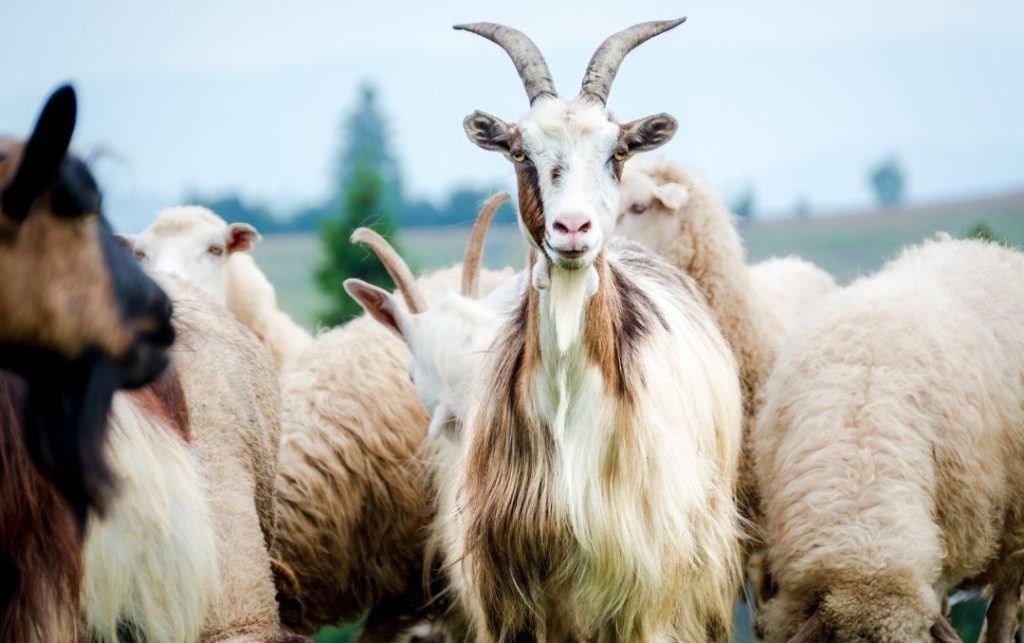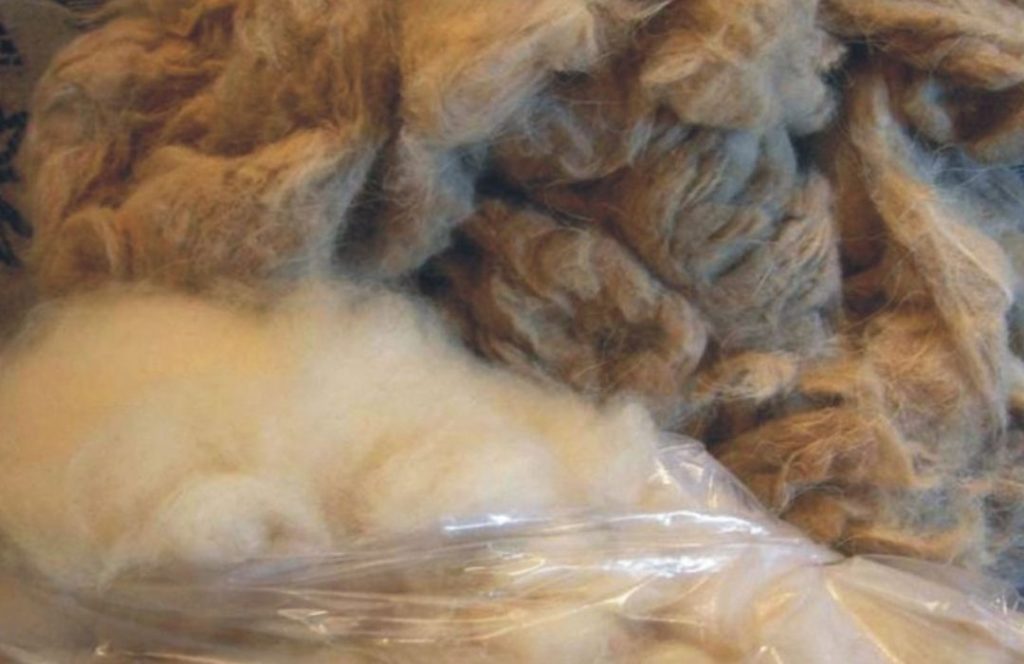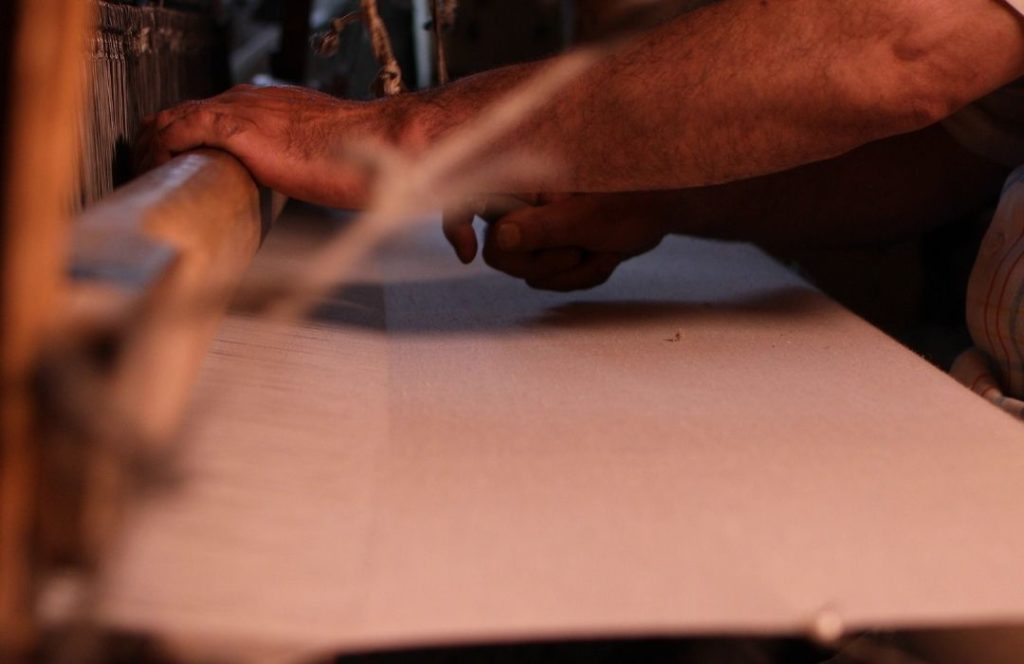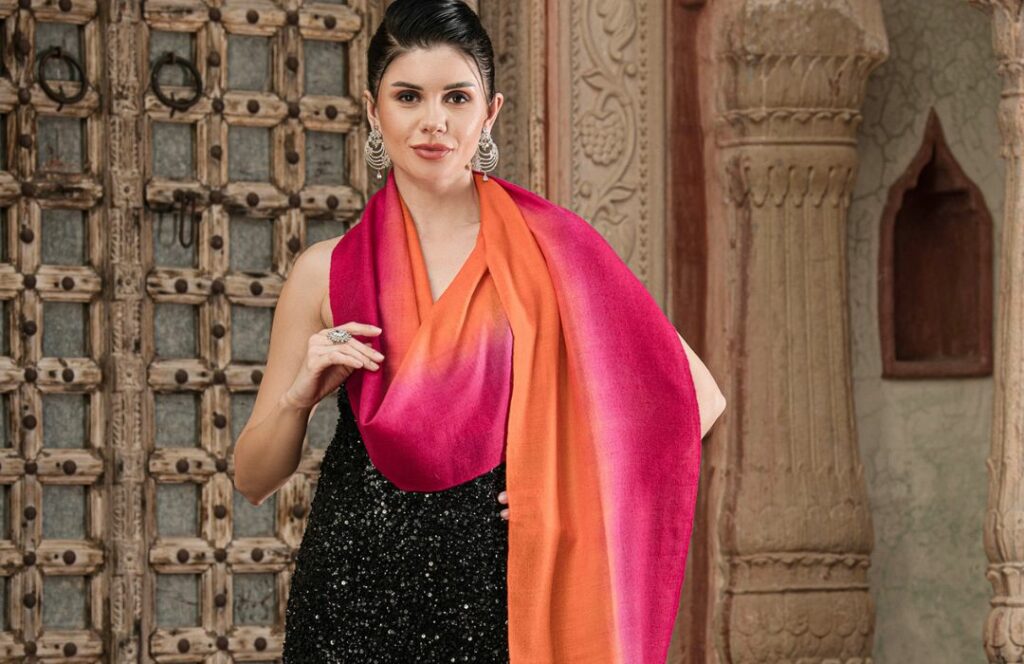The Cashmere scarf is a tribute to the best luxury found in nature, and it originated in the highlands of Kashmir. Warmth and ethereal lightness all woven into this fabric, spun from the delicate undercoat of the Changthangi goat, which is native to the Himalayan plateaus. Its fragile yet resilient gossamer threads contain centuries' worth of artistry, craftsmanship, and tradition. The texture is so beautiful that it melts against the skin with a single touch, draping like a second breath of air—weightless, fluid, and peacefully warm.
The Cashmere scarf, a symphony of hand-spun elegance passed down through the years, and it is more than just an accessory. It offers both practical warmth and visual appeal, embodying a fusion of modern sophistication and antiquity. Every scarf conveys a tale of handcrafted skill, whether embellished with elaborate Sozni embroidery, majestic Kani weaves, serene ombre shades, worthy patterns and Aksi, or left unadorned in its unadulterated, minimalist splendor of Solids. Its hand-combed and carefully spun fibers become a fabric that withstands the test of time, enveloping the wearer in a softness that only gets deeper with every use.
Wearing a cashmere scarf is more than just wearing it; it's an experience, a companion to both fresh winter mornings and starry autumn evenings, a whisper of the mountains around your shoulders. Because of its adaptability, it adds a subtle charm to any outfit, regardless of the season. It exudes sophistication and understated luxury whether tied beautifully around the neck, draped freely over a coat, or falls in gentle folds over the shoulders. In the world of fine textiles, the cashmere scarf is still a sought-after relic, an everlasting memento, a work of art, and a symbol of discriminating taste.
Procuring the finest Cashmere
The Changthangi goats, who roam the snow-capped plateaus of Ladakh, are the starting point for acquiring the best cashmere. These uncommon animals create an undercoat of incredibly fine threads to protect themselves from the bitter cold as temperatures drop in the middle of winter. The basis of genuine cashmere is this priceless down, naturally lost as spring approaches. After being carefully combed by hand, these fragile fibers all ethically sorted for purity. Thus, guaranteeing only the softest, most immaculate strands proceed on their path to become a beautiful fabric.
The journey from raw fiber to a luxurious masterpiece is a story of artisanal commitment. The fibers, twisted into light threads by spinners, who frequently possess centuries of inherited expertise, maintaining the fibers' natural warmth and durability. An inheritance of nature's greatest gift, weaved with human skill, is what results from leaving a textile unaltered in its most basic state or embellished with the elaborate designs of hand embroidery and weaves.

Goats that produce cashmere come in a variety of breeds. A particular percentage of the total production thus attributed to each breed. Among the various breeds are the Tibetan Plateau, Liaoning, Inner Mongolia, Zhonghwei, Australian Goat, Changthanghi, and Luliang breeds. As a result, the cashmere wool generates warmth efficiently produced by all breeds. A uncommon species of goat is the Changra Goats, a special breed.
Furthermore, the goats only produce the exquisite cashmere fiber once a year. As a result, only between 80 to 170 grams of Ladakhi Cashmere are made annually. Consequently, regarded as the rarest. Since there are about 400 million cashmere-producing goats worldwide, other breeds of it also yield multiple times as much.
Crafting of a Cashmere Scarf
The handicrafts of Kashmir's tradition are extremely opulent. Among the other high-end handicrafts is Pashmina Craft. The finest wool, known as cashmere, obtained from a rare breed of goat known as changra goats. In order to create the luxury of cashmere, Kashmiri Pashmina Art showcases the artistry of its craftspeople. Thus, the finest cashmere, crafted using Changra goats, who live at the base of Changhthanghi in Ladakh. Pashmina, an indigenous craft associated with luxury clothes made of Cashmere.

To guarantee the purest, most lustrous fibers left. Thus, the finest Cashmere fibers all first hand-combed from the Changthangi goat. These delicate strands then go through a rigorous cleaning and sorting procedure. The tufts of finest Cashmere wool all sorted and cleaned on their arrival. The artisans cheerfully welcome the Cashmere wool. After cleaning, the Cashmere wool is dried. The next step is the distribution of clean Cashmere Wool to the households of Kashmir. In numerous households, the women of the family work upon the Cashmere wool on a yinder. Yinder is a wooden wheel used for the process of Spinning. Spinning, the translation of Cashmere wool to Cashmere yarn.The cloth thus guaranteed to maintain its ethereal softness and durability throughout time because to this age-old method. All frequently handed down through the generations.
The women spindle the Cashmere wool on yinder while humming the folk songs of Kashmir. Therefore, the finest Cashmere yarn is crafted by the process of Spinning. The Cashmere yarn is the finest and softest yarn. It is 12 to 16 microns in diameter.
Weaving and Designing
After being spun, the threads all given to skilled weavers creating the cloth on wooden handlooms. Whether in the intricate weave, the delicate hand-embroidered design, or the traditional plain drape, every thread efficiently intertwined with rhythmic accuracy to produce a seamless weave. A single scarf might take weeks or even months to finish, depending on the level of craftsmanship required, with each motif and pattern meticulously created to perfection. Whether it's a hand-rolled hem or elaborate embroidery, the finishing touch transforms the scarf into a work of silent luxury. Thus, exemplifing the timeless tradition of Cashmere artistry.

History of Pashmina Craft
A Persian saint's journey around the world was the beginning of it all. Mir Syed Ali Hamdani was a Middle Eastern sage. Along with 700 artisans, the footprints of a saint from the Middle East named Mir Syed Ali Hamdani traveled to Kashmir to spread the gospel and enhance the valley's natural beauty. In the Changhthanghi Ladakh region, he laid his feet. As a result, the saint appeared on Ladakh's Changhthangi Mountain. As he observed the natural world, he fixed his gaze on the goat with the amazing wool. He was so impressed by the wool's softness and fineness that he turned it into socks and gave them to the Sultan Zain-ul-Abideen of the Kashmir Valley.
Since the 13th century, Kashmir's beauty serenely dominated by the Pashmina craft. It is a gift from the Persian saint who found the uncommon goat species in Chanthanghi. He embodied Kashmir's Pashmina Craft elegance. The royals then embellished the Pashmina Craft. This art form has endured for centuries, demonstrating its influence on people all across the world. The majority of Pashmina accessories were owned by Europeans for ages. In order to supplement her beauty with luxury, French monarch Josephine possessed about 400 Kani Pashmina Shawls from Kashmir. Emperor Akbar of India loved the Pashmina shawl so much that he gave it the noble moniker "parm-narm," which translates to "supremely soft."
Pashmina crafts are multipurpose and associated with luxury. There are three primary accessory styles in the Pashmina craft: Pashmina Shawls, Cashmere Scarves, and Cashmere Wraps. The fundamental processes of Pashmina craft, such as spinning, weaving, and designing, all used to create each type.
Reasons why a Cashmere Scarf is high-quality and luxurious
With its unmatched warmth and softness, a cashmere scarf is the height of luxury and stands out from all other textiles. This beautiful fiber, which comes from the undercoat of the endangered Changthangi goat, is only 12 to 16 microns in diameter. Thus, making it feel nearly weightless. It is even finer than human hair. In contrast to regular wool, cashmere has a natural ability to regulate body temperature, keeping warm in the winter and allowing for breathability in milder regions. Its feathery lightness and inherent insulation make for a scarf both comfortable and elegant, enclosing the wearer in a cocoon of subtle grace.
A cashmere scarf's fine craftsmanship is what really makes it stand out as being of superior quality. Every step wholely carried out precisely, from hand-combing and sorting to spinning and weaving. Thus, guaranteeing that only the best fibers are utilized. Expert craftspeople spend weeks or even months creating a single item using traditional techniques like weaving and hand-embroidery, which enhance its creativity. The outcome is a scarf that is not only incredibly soft but also incredibly beautiful over time; it doesn't pill, gets softer with time, and keeps its elegant drape for many years to come.
A cashmere scarf symbolizes exclusivity and lineage in addition to its physical elegance. Since only a little quantity of pure cashmere is obtained year, its rarity raises its status. True Cashmere scarves thus handcrafted with an artisanal touch, making each piece distinctive in contrast to mass-produced textiles. A cashmere scarf, a timeless piece of elegance that is an investment in both style and tradition. Also, regardless of whether worn as a subtle touch of sophistication or as a declaration of sophisticated taste.
Also read: PASHMINA VS CASHMERE : KNOW THE DIFFERENCE
The richness of Cashmere at Pashmina.com

The richness of a cashmere scarf, revealed on our site in a symphony of textures, colors, and decorations, each one expertly designed to exude unmatched beauty. Our ombre cashmere scarves are a captivating gradient of color reflecting the changing tones of dawn and twilight because they flow smoothly from one hue to another. These feather-light yet warm scarves combine classic refinement with modern sophistication to create a gentle stream of colors. Thus, effortlessly and gracefully enhance any look.
Our Swarovski Crystal Cashmere Scarves, embellished with carefully placed. Thus, dazzling crystals reflecting light like dewdrops on morning silk, are perfect for individuals who desire richness. Cashmere, transformed into an evening statement by this luminous adornment radiating a subtle glamor that is both elegant and ethereal. Our Solid Cashmere Scarves, on the other hand, are still a timeless favorite since they are simple, pure, and incredibly soft. Perfectly woven, they highlight the unadorned beauty of good cashmere. Also, their classic appeal makes them a must-have for anybody who values understated luxury. Every scarf on our site is a celebration of workmanship, legacy, and timeless elegance. Whether it is in a dazzling gradient, a sparkling accent, or an understated classic.
Also read: CRAFTING OF SHIBORI PASHMINA SHAWL